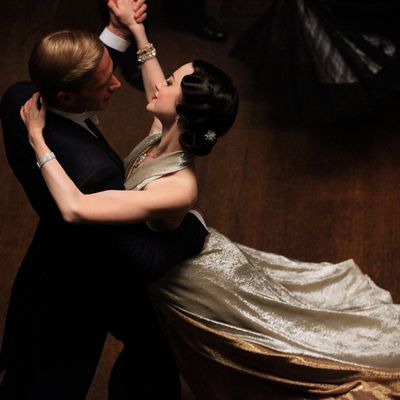
Surely mine won’t be the first joke made about the Material Girl making a Material Movie. Madonna’s W.E., about the legendary romance between American divorcée Wallis Simpson and King Edward VIII, seems to find as much soul in objects as it does in people — which is perhaps ironic for a tale of tempestuous passion and lives abandoned for the sake of desire. (Edward abdicated his throne in 1936 in order to marry Wallis, and they became the Duke and Duchess of Windsor.) As such, this love story is a surprisingly chilly affair — but not always in a bad way. It’s a mess, and occasionally ridiculous, but it has a cool, pointed beauty all its own.
The film actually interweaves two stories: The first is that of Wallis (Andrea Risborough) and Edward (James D’Arcy) — she’s been unhappily wed once before and is currently married to pleasant, obliging Ernest (David Harbour). She and Edward first meet at a party, and, having prepared obsessively for their introduction, she’s already seducing him, even if she doesn’t realize it yet. The then–Prince of Wales soon becomes quite taken with her, and her husband reluctantly tolerates their growing intimacy. The love affair itself is treated as a whirlwind of parties, dances, and foreign travel; the things, perhaps, of a young girl’s fantasy. Edward’s family is up in arms, of course, but no matter — this is a man in love. Even his abdication is treated like the act of a hopeless romantic, not that of a monarch who threw his country into turmoil while the rest of Europe was starting to burn.
The second story, which serves as a framing device set in 1998, belongs to Wally Winthrop (Abbie Cornish), a well-heeled but unhappily married society beauty who finds herself obsessed with an exhibit of Wallis and Edward’s personal objects ahead of a Sotheby’s auction. Wally was named after Wallis, but her fondness for the historic lovers likely goes deeper: Her shrink husband is cheating on her, she’s desperate to have a child, and she seems to find genuine solace in the vestiges of this supposed Royal fairy tale. Under the watchful eye of a hunky Russian security guard (Oscar Isaac), who will predictably play a bigger role in her life, she repeatedly visits the exhibit. As Wally’s eyes and hands hover over the fine china, silverware, tablecloths, and jewelry, the older story comes to life before our eyes.
Well, almost: The fluid camera dances among teacups and cocktail glasses as much as it does the faces, and characters rarely come into focus. Even the framing device of the Sotheby’s auction suggests a kind of material transmigration of the soul — as if our doomed, legendary lovers somehow managed to fragment and bury their spirit in a thousand glistening knickknacks. Madonna cuts rapidly between the different time periods of the film, and we may wonder if all this frenzied storytelling is deliberately withholding something. Turns out it is: A touching revelation in the third act actually winds up justifying the film’s aesthetic, but it also feels like a bit of an afterthought, because the script hasn’t set it up properly.
And yet, for all that, W.E. kind of works. Madonna knows something about movement, attraction, and seduction. The women in her film walk gracefully and command the center of the screen, while the men always seem to hover along the edges, even when one is the King of England. The whole thing feels like a dance of seduction, and we, like Edward, can’t take our eyes off Risborough’s Wallis. “I’ve never seen one person so utterly possessed by another as he was by her,” someone says about them later on, and we know what they’re talking about.
Love might not be the right word here: After Edward gives her a series of crosses during a whirlwind European tour, Wallis tells him he “knows the way to a girl’s heart.” “I wasn’t aiming that high,” he replies. Their relationship is somehow both all-consuming and all surface. It’s not like they sit around and talk about literature or anything; rather, she mixes drinks, dances, and looks fabulous in carefully chosen dresses, while all he has to do is be a prince. That may sound like a condemnation, but it seems to be the essence of the story Madonna is trying to tell, one of status, artifice, and illusion. When we first see Wallis, in a flashback to her first marriage, she seems elegant, poised, and graceful, only to be quickly beaten down by her brute of a first husband. She needs someone who will match the needs of her imagined self. So what if it’s all surface? Look hard enough at surfaces, the film seems to be saying, and you’ll find souls trapped within.


